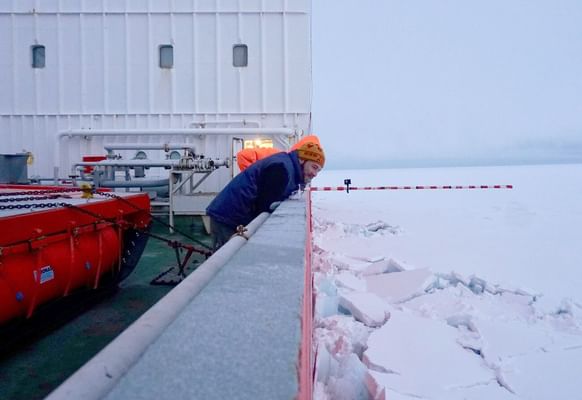- Undergraduate
Bachelor's Degrees
Bachelor of ArtsBachelor of EngineeringDual-Degree ProgramUndergraduate AdmissionsUndergraduate Experience
- Graduate
Graduate Experience
- Research
- Entrepreneurship
- Community
- About
-
Search
All Thayer News

Largest Arctic Research Expedition of All Time Concludes
Oct 13, 2020 | by Julie Bonette
After more than a year in the Central Arctic, the research icebreaker Polarstern returned to her homeport in Bremerhaven, Germany on Monday, October 12, marking the end of the record-breaking Multidisciplinary drifting Observatory for the Study of Arctic Climate (MOSAiC) expedition. Never before has an icebreaker ventured so far north during the Arctic winter, and never before has an international team of researchers comprehensively gathered such urgently needed climate data in the region of the world hardest hit by climate change.

Dartmouth engineering graduate student Ian Raphael '18 watches an ice thickness test. (Image courtesy of Ravenna Koenig/NPR)
Even as the last leg of MOSAiC concluded, researchers, including a team of Dartmouth engineers, have already started the next phase: analyzing and interpreting the approximately 100 terabytes of data produced, which could take a decade or more.
“The data is the legacy. This data set will be used by scientists for years and decades to come, so that’s really pretty exciting,” said Dartmouth engineering professor Donald Perovich, co-lead for MOSAiC’s sea ice team and a member of the MOSAiC Project Board.
According to Perovich, the goal now is to use the data collected from what he calls “the new Arctic” to better understand the causes and consequences of diminishing sea ice. The arduous task is especially important as another expedition on this scale is unlikely for many years.
“MOSAiC is providing many insights on what’s happening, but as human beings, we are never satisfied with just knowing what’s happening now, we want to know what’s going to happen in the future,” said Perovich. “Our best means of looking ahead into the future are through climate models, and MOSAiC was designed with those models in mind. Once our data is incorporated into these models, I expect there will be much better predictions about future Arctic states.”
""MOSAiC is providing many insights on what’s happening, but as human beings, we are never satisfied with just knowing what’s happening now, we want to know what’s going to happen in the future.""
Donald Perovich, Professor of Engineering
On September 20, 2019, Polarstern departed from the Norwegian port of Tromsø bound for the Central Arctic, the epicenter of climate change. Once there, the ship allowed itself to become trapped in the ice and began a one-year-long drift across the North Pole, completely at the mercy of natural forces—the route and speed were solely determined by the ice drift, powered by wind and currents.
Over the five cruise legs of the expedition, a total of 442 researchers, Polarstern crewmembers, young investigators, teachers, and members of the press took part. Seven ships, several aircraft, and more than 80 institutions from 20 countries were involved. The researchers, who hailed from 37 countries, had a common goal: to investigate complex interactions in the climate system between the atmosphere, ice, and ocean, so as to better represent them in climate models. They also explored life in the Central Arctic for an entire year. Now they have returned home with a wealth of impressions from the rapidly transforming Arctic, and with an unparalleled treasure trove of data, which an entire generation of climate researchers will focus on analyzing.
Even when, due to the coronavirus pandemic, virtually every other expedition around the globe was cancelled, MOSAiC was able to continue. As such, the MOSAiC expedition achieved its goal: to monitor the epicenter of climate change more precisely than ever before, and over the span of an entire year—and by doing so, to take a crucial step forward in our understanding of the Earth’s climate system and how it is changing.
“I’m very pleased with how the MOSAiC expedition progressed, and what a complete success it has been. Through the expedition, we can provide the climate data and observations that humanity so urgently needs in order to make fundamental and pressing political decisions on climate protection,” said Professor Markus Rex, Expedition Leader and head of the MOSAiC project, Alfred Wegener Institute, Helmholtz Centre for Polar and Marine Research.
“We’ve seen how the Arctic ice is dying. In the summer, even at the North Pole, it was characterised by extensive melting and erosion. If we don’t make immediate and sweeping efforts to combat climate warming, we’ll soon see ice-free Arctic summers, which will have incalculable repercussions for our own weather and climate. Though today the Central Arctic remains a fascinating, frozen landscape in winter, the ice is only half as thick as it was 40 years ago, and the winter temperatures we encountered were nearly always ten degrees warmer than what Fridtjof Nansen experienced on his ground-breaking Arctic expedition over 125 years ago.”
For contacts and other media information visit our Media Resources page.
